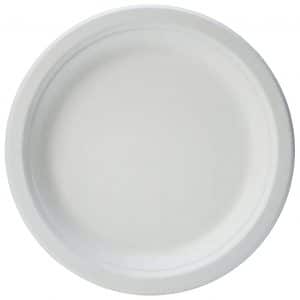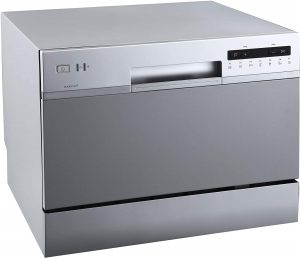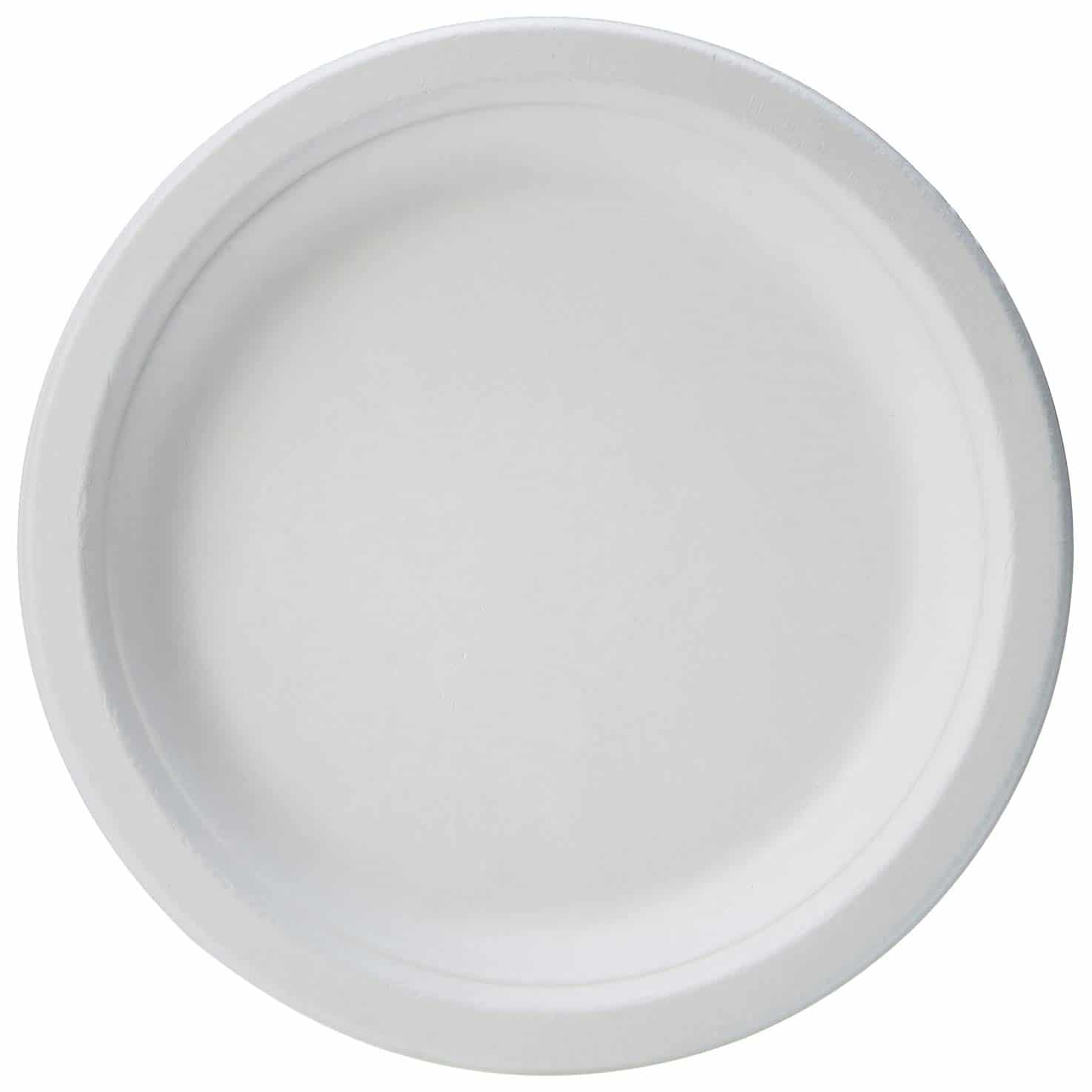Whether you’re concerned about the environment or trying to cut back on water usage, the dishwasher vs. paper plates comparison will be an ongoing debate. Both are convenient and easy to use. You can also save time with either option.
However, before you can compare the two you need to have the facts. This way, you’ll be able to make an informed opinion that fits your lifestyle.
Comparing the Costs and Time
The following chart highlights the average cost a family of four can expect to pay annually for paper plates or to run their dishwasher (assuming daily dishwasher washing)
| Electricity Used Per Cycle and Cost | Water Used Per Cycle and Cost | Detergent, Salt, Rinse Aid | Number of Plates Used Daily and Cost | Average Annual Total | |
| Dishwasher | 1.5kWh @ $0.17 | 3 gal @ $0.03 | 0.20$ | – | $146.00 |
| Paper Plates | – | – | – | 12
1,000 pack @ $30.00 |
$130.00 – $150.00 |
It should be noted that this table is based on the average electricity and water usage of a top-rated Energy Star dishwasher and could be higher depending on your model. Water and electricity rates also vary around the country.
Keep in mind that the dishwasher can be loaded with more than 12 plates and a lot of tableware. So, besides paper plates, you should also add the cost of tableware.
This stat estimates that an average dishwasher runs 215 loads per year. But that depends on the size of the dishwasher and how many family members you have. The cost per cycle is between 0.4$ and 0.46$ per load depending on the dishwasher’s energy rating.
You might also want to think about how much time you spend loading and unloading the dishwasher, it might be more than you realize.
| Daily | Annually | |
| Time Spent Loading a Dishwasher (without rinsing) | 3 minutes | 1095 minutes |
| Time Spent Unloading a Dishwasher (assuming your dishwasher can dry dishes) | 5 minutes | 1825 minutes |
Times can vary depending on the size of the kitchen and the number of dishes. This chart is based on loading and underloading place settings for a family of four.
More on Costs
Paper plates are inexpensive, even if you buy a name brand. On average, 30 paper plates are priced between $3 – $4. They can be even cheaper online. Some online sites market 1,000 paper plates for $30-80$, depending on the quality.
For example, these 1000 plates cost about 80$, or 9 cents per plate. Here is the link to the 1000 paper plates set on Amazon.

This means that you’ll have enough plates for a family of four to eat three meals a day for 11 weeks (83 days). Even though buying a set of dishes is a one-time purchase, you still need to wash, dry, and put them away after every meal. Paper plates are an inexpensive and time-saving option that busy families often depend on.
A typical dishwasher cost between $400 and $700, but it’s an investment that should last at least 5 years. The cost of maintenance is not high and they are reliable.

Most houses and apartments have a dishwasher. It used to be a “luxury” appliance and now it’s considered almost as standard as a refrigerator or oven. It makes washing dishes a breeze.
You simply rinse the dish and place it on the rack. Toss in some dishwashing detergent and the appliance does the rest. It can even dry dishes, taking this step out of your list of chores.
This convenience comes at a cost, even if you didn’t purchase the dishwasher. If you have an Energy-Star rated appliance the overall costs will be lower. Per cycle, an Energy Star rated model will use 4 gallons of water compared to the 6 used by a standard dishwasher.
There will also be an additional energy cost. Even if you set the appliance on “air dry”, it still uses electricity during the “wash” and “rinse” cycles.
Energy-saving appliances on average use 0.87 kWh per cycle. Standard models typically use 1.59 kWh per load. If you only run your dishwasher once a week, there probably won’t be a noticeable increase in your water and electric bills. However, if you’re using it almost daily, the costs will add up.
If you’re looking for ways to cut back on energy and water usage, switching to paper plates could be a cost-effective option.
Environmental Impact
Paper plates might be cheaper than running the dishwasher, but over time the trash will add up. Paper plates are biodegradable, though it is not a quick process. According to the New York City Department of Sanitation, it takes 5-years on average for paper plates to decompose.
Another problem with paper plates is that they are not recyclable. Once food has touched the plate it is automatically designated as “trash”.
With an estimated 64 billion paper plates and cups being thrown away each year, disposal sites can quickly fill up. However, paper plates are a better option than sturdier plastic dishes.
There’s also the issue of transport. Every time a dishwasher or paper plates are transported it affects the environment. Paper plates do travel more than a dishwasher.
Surprisingly to some people is the fact that a dishwasher can have a smaller carbon footprint than paper dishes. There are a few guidelines to follow if you want to wash dishes and be eco-friendly.
The first step is to only run your dishwasher when it’s full. The second step is to not rinse your dishes before putting them in. Detergent has advanced enough to be able to remove stubborn, stuck-on food without wasting water pre-rising.
The final step is to skip the “dry” cycle. The hot water used during the rinse cycle will quickly evaporate if you open the dishwasher door. If you’re worried about water spots on your glasses and silverware, most detergents come with an anti-spotting agent. A quick wipe down with a dry towel will also remove any spots.
If you follow those guidelines, you can be eco-friendly and use your dishwasher. It is also better for the environment than paper plates.
Benefits and Disadvantages of Both
There are benefits and disadvantages associated with both dishwashers and paper plates. Some of these are minor, while others may make you change your mind about which one you’re using.
Dishwasher:
Advantages
- Energy-saving models leave a small carbon footprint
- Can be cost-efficient if guidelines are followed
- Convenient and easy to use
- Frees up time for things you enjoy
- Disinfects dishes via hot water
Disadvantages
- Water and electricity can be wasted if it’s not an Energy Star rated model
- Can be costly if used often
- Repairs/replacement can be expensive
While the type of dishwasher does matter – Energy Star models are more efficient – you can be environmentally friendly and eat off of traditional dishes without it being expensive.
Paper Plates:
Advantages
- Extremely inexpensive even for a family of four
- Convenient to use
- You won’t be washing dishes after a meal
- Eco-friendly (Biodegradeable)
- Great for picnics/potlucks
Disadvantages
- It takes an estimated 5-years to biodegrade
- Are not recyclable if they have food residue
- Due to high volume, they leave a large carbon footprint
Which is Best: Dishwasher or Paper Plates
Paper plates can save you money on utility bills. This is especially true if you use the dishwasher several times a week. Paper dishes are also inexpensive, and biodegradable though it does take several years.
There is the matter of the amount of travel involved with paper plates. It can leave a substantial carbon footprint. It starts at the manufacturing plant and continues until the plates finally reach the landfill.
Dishwashers that are rated Energy Star are the better option if the environment is your primary concern. Energy-saving models use less water and electricity than most people think.
The carbon footprint is further reduced if the dishwasher is only run when it’s full. It’s even eco-friendly when it comes to travel. The dishwasher spends less time in transport than paper dishes.
This isn’t to say that there’s no use for paper plates. They’re more convenient at a picnic, potluck or other large gatherings than a mountain of dishes. In this case, go with paper. It’s cheaper, more convenient and eco-friendlier than several dishwasher loads.
